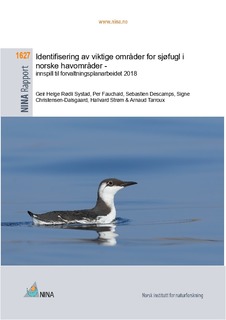| dc.contributor.author | Systad, Geir Helhe Rødli | |
| dc.contributor.author | Fauchald, Per | |
| dc.contributor.author | Deschamps, Sebastian | |
| dc.contributor.author | Christensen-Dalsgaard, Signe | |
| dc.contributor.author | Strøm, Hallvard | |
| dc.contributor.author | Tarroux, Arnaud | |
| dc.coverage.spatial | Norge, Svalbard, Norske havområder, Grønlandshavet, Barentshavet, Norskehavet, Nordsjøen, Skagerrak | nb_NO |
| dc.date.accessioned | 2019-04-12T13:13:56Z | |
| dc.date.available | 2019-04-12T13:13:56Z | |
| dc.date.issued | 2019 | |
| dc.identifier.isbn | 978-82-426-3370-5 | |
| dc.identifier.issn | 1504-3312 | |
| dc.identifier.uri | http://hdl.handle.net/11250/2594535 | |
| dc.description.abstract | Systad, G.H.R., Fauchald, P., Descamps, S., Christensen-Dalsgaard, S., Strøm, H. & Tarroux, A. 2019. Identifisering av viktige områder for sjøfugl i norske havområder – innspill til forvaltningsplanarbeidet 2019. NINA Rapport 1627. Norsk institutt for naturforskning.
Denne rapporten omhandler viktige områder for sjøfugl i åpent hav og langs kysten, som et innspill til oppdatering av forvaltningsplanene for norske havområder i 2019. Delen som dekker åpent hav kobler transektdata med loggerdata fra fugler hentet fra SEATRACK-prosjektet under SEAPOP-programmet. Forekomstene relateres til bestandstilhørighet ut fra hekkekoloniene til fuglene som er merket med lysloggere. Bestandene er relatert til havområdene koloniene er tilknyttet, grovt sett klassifisert som Grønlandshavet, Barentshavet, Norskehavet og Nordsjøen. Ut fra disse datasettene er det beregnet viktige område for sjøfugl i åpent hav. Resultatet viser at områdene rundt hekkekoloniene er viktigst siden fuglene konsentreres i disse områdene gjennom store deler av året.
Kystdatasettet beskriver anbefalte utvidelser av eksisterende SVO-områder langs Norskekysten og på de arktiske øyene samt forslag til opprettelse av nye slike. Anbefalingene er fokusert på beiteområdene til sjøfugl, og da spesielt pelagisk beitende sjøfugl. Områdene som er angitt, dekker stort sett havområdene 100 km ut fra koloniene, for eksempel rundt Bjørnøya. Modelleringen i åpent havdelen støtter denne tilnærmingen. I tillegg er det foreslått endringer av noen områder som dekker andre funksjoner enn hekking, for eksempel Ytre Oslofjorden. | nb_NO |
| dc.description.abstract | Systad, G.H.R., Fauchald, P., Descamps, S., Christensen-Dalsgaard, S., Strøm, H. & Tarroux, A. 2019. Identification of important areas for seabirds in Norwegian oceans - input to the national management plans 2019. NINA Report 1627. Norwegian Institute for Nature Research.
This report deals with important areas for seabirds in open sea and along the Norwegian coast, as an input for updating the management plans for Norwegian Oceans areas in 2019. The part that covers open sea links transect data with light logger data from birds obtained from the SEATRACK project under the SEAPOP program. The distribution is analysed for each of the populations based on the birds marked with light loggers from the different breeding colonies. The populations are related to the marine areas the colonies are associated with, roughly classified as the Greenland Sea, the Barents Sea, the Norwegian Sea and the North Sea. Based on these data sets, important area for sea birds in open sea is calculated. The result shows that the areas around the breeding colonies are most important since the birds are concentrated in these areas throughout much of the year.
The coastal data set describes recommended extensions of existing SVO areas along the Norwegian coast and on the Arctic islands, as well as suggestions for establishing new ones. The recommendations are focused on the feeding areas of seabirds, and especially pelagic feeding seabirds. The areas that are stated cover mostly the sea areas 100 km out from the colonies, for example around Bjørnøya. The modelling results in the open sea section supports this approach. In addition, changes have been proposed in some areas that cover functions other than breeding, such as the Outer Oslo Fjord area. | nb_NO |
| dc.language.iso | nob | nb_NO |
| dc.publisher | Norsk Institutt for Naturforskning (NINA) | nb_NO |
| dc.relation.ispartofseries | NINA Rapport;1627 | |
| dc.subject | Sjøfugl | nb_NO |
| dc.subject | alkefugl | nb_NO |
| dc.subject | måker | nb_NO |
| dc.subject | skarv | nb_NO |
| dc.subject | andefugl | nb_NO |
| dc.subject | Lomvi | nb_NO |
| dc.subject | polarlomvi | nb_NO |
| dc.subject | alke | nb_NO |
| dc.subject | alkekonge | nb_NO |
| dc.subject | lunde | nb_NO |
| dc.subject | teist | nb_NO |
| dc.subject | krykkje | nb_NO |
| dc.subject | Forvaltningsplan | nb_NO |
| dc.subject | overvåkning | nb_NO |
| dc.subject | kartlegging | nb_NO |
| dc.subject | Hekkebestander | nb_NO |
| dc.subject | vinterbestander | nb_NO |
| dc.subject | mytebestander | nb_NO |
| dc.subject | Seabirds | nb_NO |
| dc.subject | alcids | nb_NO |
| dc.subject | gulls | nb_NO |
| dc.subject | cormorants | nb_NO |
| dc.subject | ducks | nb_NO |
| dc.subject | Common Guillemot | nb_NO |
| dc.subject | Brünnichs Guillemot | nb_NO |
| dc.subject | Razorbill | nb_NO |
| dc.subject | Little Auk | nb_NO |
| dc.subject | Atlantic Puffin | nb_NO |
| dc.subject | Black Guillemot | nb_NO |
| dc.subject | Blacklegged Kittiwake | nb_NO |
| dc.subject | Mangement plans | nb_NO |
| dc.subject | monitoring | nb_NO |
| dc.subject | mapping | nb_NO |
| dc.subject | Breeeding populations | nb_NO |
| dc.subject | wintering populations | nb_NO |
| dc.subject | moulting populations | nb_NO |
| dc.title | Identifisering av viktige områder for sjøfugl i norske havområder - innspill til forvaltningsplanarbeidet 2018 | nb_NO |
| dc.type | Research report | nb_NO |
| dc.rights.holder | © Norsk institutt for naturforskning Publikasjonen kan siteres fritt med kildeangivelse | nb_NO |
| dc.source.pagenumber | 42 | nb_NO |
| dc.relation.project | Miljødirektoratet: M-1353|2019 | nb_NO |
